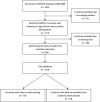Global dietary quality, undernutrition and non-communicable disease: a longitudinal modelling study
- PMID: 26758259
- PMCID: PMC4716260
- DOI: 10.1136/bmjopen-2015-009331
Global dietary quality, undernutrition and non-communicable disease: a longitudinal modelling study
Abstract
Objectives: To determine the relationship between global dietary energy availability and dietary quality, and nutrition-related health outcomes.
Design: A worldwide longitudinal modelling study using country-level data. Data on total dietary energy availability and dietary energy from 10 distinct food groups (as a proxy for dietary quality) were obtained from the FAO Food Balance Sheets database. Indicators of development were abstracted from the World Bank's World Development Indicators database. Data on nutrition and health outcomes were taken from the WHO mortality database and major cross-country analyses. We investigated associations of energy availability from food groups and health and nutrition outcomes in the combined data set using mixed effects models, while adjusting for measures of development.
Population: 124 countries over the period 1980-2009.
Main outcome measures: Prevalence of stunting in children under 5 years and mortality rate from ischaemic heart disease (IHD) in adults aged 55+ years.
Results: From 1980 to 2009, global dietary energy availability increased, and rates of child stunting and adult IHD mortality declined. After adjustment for measures of development, increased total dietary energy availability was significantly associated with reduced stunting rates (-0.84% per 100 kcal increase in energy, 95% CI -0.97 to -0.72) and non-significantly associated with increased IHD mortality rates (by 4.2 deaths per 100,000/100 kcal increase, 95% CI -1.85 to 10.2). Further analysis demonstrated that the changing availability of energy from food groups (particularly fruit, vegetables, starchy roots, meat, dairy and sugar) was important in explaining the associations with health outcomes.
Conclusions: Our study has demonstrated that by combining large, publicly available data sets, important patterns underlying trends in diet-related health can be uncovered. These associations remain even after accounting for measures of development over a 30-year period. Further work and joined-up multisectoral thinking will be required to translate these patterns into policies that can improve nutrition and health outcomes globally.
Keywords: EPIDEMIOLOGY; NUTRITION & DIETETICS; PUBLIC HEALTH.
Published by the BMJ Publishing Group Limited. For permission to use (where not already granted under a licence) please go to http://www.bmj.com/company/products-services/rights-and-licensing/
Figures



Similar articles
-
The Nutrition Transition and the Double Burden of Malnutrition in Sub-Saharan African Countries: How Do These Countries Compare with the Recommended LANCET COMMISSION Global Diet?Int J Environ Res Public Health. 2022 Dec 14;19(24):16791. doi: 10.3390/ijerph192416791. Int J Environ Res Public Health. 2022. PMID: 36554669 Free PMC article.
-
Dietary diversity, food insecurity and the double burden of malnutrition among children, adolescents and adults in South Africa: Findings from a national survey.Front Public Health. 2022 Sep 23;10:948090. doi: 10.3389/fpubh.2022.948090. eCollection 2022. Front Public Health. 2022. PMID: 36211708 Free PMC article.
-
A mixed methods study to assess the effectiveness of food-based interventions to prevent stunting among children under-five years in Districts Thatta and Sujawal, Sindh Province, Pakistan: study protocol.BMC Public Health. 2017 Jan 5;17(1):24. doi: 10.1186/s12889-016-3976-y. BMC Public Health. 2017. PMID: 28056945 Free PMC article. Clinical Trial.
-
Community-level interventions for improving access to food in low- and middle-income countries.Cochrane Database Syst Rev. 2020 Aug 5;8(8):CD011504. doi: 10.1002/14651858.CD011504.pub3. Cochrane Database Syst Rev. 2020. PMID: 32761615 Free PMC article.
-
Do nutrition and cash-based interventions and policies aimed at reducing stunting have an impact on economic development of low-and-middle-income countries? A systematic review.BMC Public Health. 2019 Oct 30;19(1):1419. doi: 10.1186/s12889-019-7677-1. BMC Public Health. 2019. PMID: 31666032 Free PMC article.
Cited by
-
Socioecological correlates of perceived cooking skills among Spanish adolescents: the EHDLA study.Front Public Health. 2025 May 20;13:1562110. doi: 10.3389/fpubh.2025.1562110. eCollection 2025. Front Public Health. 2025. PMID: 40463726 Free PMC article.
-
Trends and Correlates of Overweight among Pre-School Age Children, Adolescent Girls, and Adult Women in South Asia: An Analysis of Data from Twelve National Surveys in Six Countries over Twenty Years.Nutrients. 2019 Aug 14;11(8):1899. doi: 10.3390/nu11081899. Nutrients. 2019. PMID: 31416224 Free PMC article.
-
The effect of diet quality on the risk of developing gestational diabetes mellitus: A systematic review and meta-analysis.Front Public Health. 2023 Jan 9;10:1062304. doi: 10.3389/fpubh.2022.1062304. eCollection 2022. Front Public Health. 2023. PMID: 36699870 Free PMC article.
-
Undernutrition in children under five associated with wealth-related inequality in 24 low- and middle-income countries from 2017 to 2022.Sci Rep. 2024 Feb 9;14(1):3326. doi: 10.1038/s41598-024-53280-0. Sci Rep. 2024. PMID: 38336795 Free PMC article.
-
Diet quality indices and their associations with health-related outcomes in children and adolescents: an updated systematic review.Nutr J. 2020 Oct 24;19(1):118. doi: 10.1186/s12937-020-00632-x. Nutr J. 2020. PMID: 33099309 Free PMC article.
References
-
- Mazzocchi M, Shankar B, Traill B. The development of global diets since ICN 1992: Influences on agri-food sector trends and policies. FAO Commodity and Trade Policy Research Working Paper no.34 Rome: FAO, 2012.
-
- Smith LC, Haddad LJ. Reducing child undernutrition: past drivers and priorities for the post-MDG era. IDS Working Paper 2014;2014:1–47.10.1111/j.1574-0862.2001.tb00063.x - DOI
-
- UNICEF Levels and Trends in Child Malnutrition. (UNICEF—WHO—World Bank Group joint child malnutrition estimates) 2015.
-
- Haddad LJ, Hawkes C, Udomkesmalee E, et al. Global Nutrition Report 2014: Actions and accountability to advance nutrition and sustainable development. Washington DC, USA: International Food Policy Research Institute, 2014.
-
- Smith LC, Haddad LJ. How important is improving food availability for reducing child malnutrition in developing countries? Agr Econ 2001;26:191–204. 10.1111/j.1574-0862.2001.tb00063.x - DOI
Publication types
MeSH terms
LinkOut - more resources
Full Text Sources
Other Literature Sources
Medical
